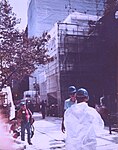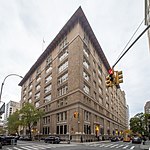Stuyvesant Apartments

The Stuyvesant Apartments, Stuyvesant Flats, Rutherfurd Stuyvesant Flats or simply The Stuyvesant, was an apartment building located at 142 East 18th Street between Irving Place and Third Avenue in the Gramercy Park neighborhood of Manhattan, New York City. It is considered to be the first apartment building in the city intended for the middle class, who previously were not used to living in apartments, which were initially called "French flats" at the time.Before the Stuyvesant, almost all of the housing in New York City consisted of either tenements or townhouses. The Stuyvesant helped to bridge this gap, satisfying the need for higher density but upscale housing. Rents ranged from $1,000 to $1,800 per year, the rough equivalents in 2015 of approximately $8,000 to $14,000 per year.The Stuyvesant was successful, leading the way for other such buildings to be constructed. In their book New York 1880, Robert A. M. Stern and his co-authors wrote that the Stuyvesant was the "foundation stone" of the movement of the middle-class into apartments.
Excerpt from the Wikipedia article Stuyvesant Apartments (License: CC BY-SA 3.0, Authors, Images).Stuyvesant Apartments
East 18th Street, New York Manhattan
Geographical coordinates (GPS) Address Nearby Places Show on map
Geographical coordinates (GPS)
| Latitude | Longitude |
|---|---|
| N 40.736 ° | E -73.9861 ° |
Address
East 18th Street 147
10003 New York, Manhattan
New York, United States
Open on Google Maps









